56th Infantry Brigade (United Kingdom)
The 56th Infantry Brigade was an infantry brigade of the British Army that saw active service in both the First and the Second World Wars.
| 56th Brigade 56th Independent Infantry Brigade 56th Infantry Brigade | |
|---|---|
 Insignia of the 56th Independent Infantry Brigade, Second World War.[1] | |
| Active | 1914–1919 1944–1946 1987–1993 |
| Country | |
| Branch | |
| Type | Infantry |
| Size | Brigade |
| Part of | 19th (Western) Division 49th (West Riding) Infantry Division |
History
First World War
The 56th Brigade was raised soon after the outbreak of the Great War in September 1914 from men, mainly from Lancashire and Northern England, volunteering for Kitchener's New Armies. The 56th Brigade was assigned to the 19th (Western) Division and served on the Western Front from 1915 and was disbanded after the war. The brigade saw service at the Battle of Loos in late 1915, and at during the Somme offensive, at Albert and Pozières and later at Messines in June 1917, Third Ypres and, in 1918, at Sambre, part of the Hundred Days Offensive.
Order of battle First World War
- 7th (Service) Battalion, King's Own Royal Regiment (Lancaster) (disbanded February 1918)
- 7th (Service) Battalion, East Lancashire Regiment (disbanded February 1918)
- 7th (Service) Battalion, South Lancashire Regiment (disbanded February 1918)
- 7th (Service) Battalion, Loyal Regiment (North Lancashire) (disbanded February 1918)
- 4th Battalion, King's Regiment (Liverpool) (from 3 December 1915 to 19 December 1915)
- 56th Machine Gun Company, Machine Gun Corps (formed 14 February 1916, moved to 19th Battalion, Machine Gun Corps 14 February 1918)
- 56th Trench Mortar Battery (formed 17 June 1916, broken up 5 February 1918, reformed 6 March 1918)
- 9th (Service) Battalion, Cheshire Regiment (from February 1918)
- 1/4th Battalion, King's Shropshire Light Infantry (from February 1918)
- 8th (Service) Battalion, North Staffordshire Regiment (from February 1918)[2]
Second World War
During the Second World War the 56th Independent Infantry Brigade was reformed in the United Kingdom on 15 February 1944. The brigade consisted of three Regular Army infantry battalions that had all seen service overseas: the 2nd Battalion, South Wales Borderers (SWB), which had fought in the Norwegian Campaign in 1940, 2nd Battalion, Essex Regiment and 2nd Battalion, Gloucestershire Regiment, which both fought at the Battle of Dunkirk in 1940.

The 56th Brigade took part in the D-Day landings on 6 June 1944, as part of the Allied invasion of Normandy, where it formed the right flank of the 50th (Northumbrian) Infantry Division on Gold Beach. It remained attached to the 50th Division until 10 June, after which it was attached to the 7th Armoured Division until 12 June, then reverting to the 50th Division and came under command of the 59th (Staffordshire) Infantry Division in early August 1944. On 20 August the brigade was permanently attached to the 49th (West Riding) Infantry Division, then commanded by Major General Evelyn Barker, a decorated veteran of the Great War. Serving alongside the 56th Brigade in the division were the 146th and 147th Infantry Brigades, along with supporting divisional units. The brigade replaced the 70th Brigade, which was disbanded due to heavy losses.
The 56th Brigade took part in the Normandy landings, liberated Bayeux on 7 June leaving the town mainly intact. All its battalions were involved in the taking of Tilly-sur-Seulles with the 2nd Essex finally investing the town. Later actions were north of St Germain d'Ectot and the liberation of Thury-Harcourt in the Suisse Normande. It was prominent in the drive towards Le Havre and the 49th was one of the assault divisions taking the city in Operation Astonia in September 1944. Continuing to fight in Belgium at Poppel and then the Netherlands it was the assault brigade for the final assault on Arnhem in April 1945. The 56th served well, and ended the war in Germany. The division came mainly under command of First Canadian Army throughout the campaign.
Order of battle Second World War

- 2nd Battalion, South Wales Borderers (until 27 April 1945)
- 2nd Battalion, Gloucestershire Regiment
- 2nd Battalion, Essex Regiment
- 7th Battalion, Royal Welch Fusiliers (from 27 April 1945)
Commanders
- Brigadier E.C. Pepper (from 27 February 1944 until 4 July 1944)
- Brigadier M.S. Ekin (from 4 July 1944, KIA 4 November 1944)
- Lieutenant Colonel M. Lewis ( Acting, from 4 to 9 November 1944)
- Brigadier W.F.H. Kempster (from 9 November until 3 December 1944)
- Lieutenant Colonel T.H. Wilsey (Acting, from 3 to 9 December 1944)
- Brigadier W.F.H. Kempster (from 9 December 1944 until 20 January 1945)
- Lieutenant Colonel R.H.C. Bray (Acting, from 20 to 23 January 1945)
- Brigadier R.H. Senior (from 23 to 27 January 1945)
- Lieutenant Colonel R.H.C. Bray (Acting, from 27 January until 6 February 1945)
- Brigadier R.H. Senior (from 6 February until 14 August 1945)
- Brigadier K.G. Exham (from 14 August 1945)
Post Second World War
The 56th Brigade was reformed in January 1987 within London District and comprised mostly Guards Public duties battalions.[3] It was seen as the successor of the London Divisions of the First and Second World Wars. It was disbanded in 1993.[4]
Victoria Cross recipients
- Lieutenant Thomas Orde Lawder Wilkinson, 7th (Service) Battalion, Loyal Regiment (North Lancashire), First World War
- Private James Miller, 7th (Service) Battalion, King's Own Royal Regiment (Lancaster), First World War
References
- Cole, Howard (1973). Formation Badges of World War 2, Britain Commonwealth and Empire. London: Arms and armour Press. p. 130.
- "19th Division". The Long, Long Trail. Retrieved 15 August 2015.
- Antony Beevor (1991). Inside The British Army. Corgi Books. pp. 232–3.
- Regiments.org, (Disbandment date)
External links
- "56 Infantry Brigade". Orders of Battle.com.
- Andrew Holborn (2010). 56th Infantry Brigade and D-Day: An Independent Infantry Brigade and the Campaign in North West Europe 1944–1945. Continuum. Retrieved 24 March 2014.
- Administrative Order No. 1: 56th Brigade - administrative orders issued in May 1944 in preparation for the Normandy landings